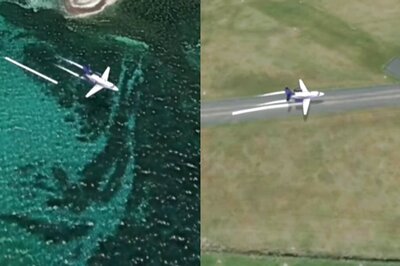
views
The second provisional list of 23 recipients for the Production-Linked Incentive (PLI) Scheme for drones and drone parts has been made public by the Ministry of Civil Aviation (MoCA).
As per the ministry, 12 drone producers and 11 drone component producers are included in the list.
The ministry issued an application invitation to qualified manufacturers on May 4 this year and the deadline for submission was May 20.
However, the unaudited financial figures for 2021–2022 and other data were used to create the tentative list of PLI beneficiaries.
As per the ministry, the beneficiaries who made the shortlist met the eligibility requirements for FY 2021–2022, which pertained to sales revenue and value addition.
It was also stated that all these enterprises’ combined yearly sales turnover climbed from Rs 88 crore in FY 2020–21 to Rs 319 crore (unaudited) in FY 2021–22.
It should be noted that value addition of more than 40% of sales turnover and an annual sales turnover of Rs 2 crore for drone companies and Rs 50 lakh for manufacturers of drone components are required to qualify for the PLI scheme for drones and drone components.
The list of drone manufacturers includes:
• Aarav Unmanned Systems, Bengaluru, Karnataka
• Asteria Aerospace, Bengaluru, Karnataka
• Dhaksha Unmanned Systems, Chennai, Tamil Nadu
• EndureAir Systems, Noida, Uttar Pradesh
• Garuda Aerospace, Chennai, Tamil Nadu
• Ideaforge Technology, Mumbai, Maharashtra
• IoTechWorld Avigation, Gurugram, Haryana
• Omnipresent Robot Technologies, Gurugram, Haryana
• Raphe Mphibr, Noida, Uttar Pradesh
• Roter Precision Instruments, Roorkee, Uttarakhand
• Sagar Defence Engineering, Pune, Maharashtra
• Throttle Aerospace Systems, Bengaluru, Karnataka
The list of drone component manufacturers includes:
• Absolute Composites, Bengaluru, Karnataka
• Adani-Elbit Advanced Systems India, Hyderabad, Telangana
• Adroitec Information Systems, New Delhi
• Alpha Design Technologies, Bengaluru, Karnataka
• Dynamake Engineering, Hyderabad, Telangana
• Imaginarium Rapid, Mumbai, Maharashtra
• SASMOS HET Technologies, Bengaluru, Karnataka
• Servocontrols Aerospace India, Belagavi, Karnataka
• Valdel Advanced Technologies, Bengaluru, Karnataka
• ZMotion Autonomous Systems, Bengaluru, Karnataka
• Zuppa Geo Navigation Technologies, Chennai, Tamil Nadu
The PLI scheme for drones and drone parts was announced last year in September to facilitate further growth of the sector.
While introducing this scheme the ministry stated: “The objective of this scheme is to incentivise manufacturing of drones and drone components in India so as to make them self-sustaining and globally competitive.”
A total incentive of Rs 120 crore is offered under the programme, which is distributed over three fiscal years and is approximately twice the aggregate revenue of all domestic drone manufacturers in FY 2020–21.
The PLI rate is 20% of the value-added, making it one of the highest such schemes.
One special aspect of the drone PLI programme is that manufacturers who fall short of the value addition requirement in 2021–2022 are still eligible to claim the lost incentive in 2022–2023.
“In case a manufacturer fails to meet the threshold for the eligible value addition in India for a particular financial year, he shall not receive any PLI for the said financial year. He will however be eligible to receive the said PLI in the subsequent year subject to him making up the said shortfall in rupee terms in the subsequent year,” noted the ministry.
It was also highlighted that by automating risky and repetitive tasks, drones have the potential to have a significant positive impact on almost every sector of the economy, including agriculture, infrastructure, emergency response, transportation, geospatial mapping, media and entertainment, law enforcement and national defence, etc. mapping and scientific research.
However, under the Atmanirbhar Bharat initiative, the Centre has aimed to construct a growth-oriented regulatory framework for drones to make India a global hub for the development, testing, production, and operation of drones by 2030. On August 25 last year, it published the liberalised Drone Rules, 2021.
Additionally, the government has carried out a series of other reforms to reach the goal. These include the publication of the Drone Airspace Map in 2021, which makes nearly 90% of Indian airspace a “green zone” up to 400 feet and the UAS Traffic Management (UTM) policy framework in 2021, as well as the Drone Certification Scheme in 2022, which makes it simpler for drone manufacturers to obtain a type certificate.
The Drone Import Policy in 2022, which forbids the import of drones made abroad, and the Drone (Amendment) Rules in 2022 are also part of the initiatives taken by the government.
Read all the Latest News, Breaking News, watch Top Videos and Live TV here.



















Comments
0 comment